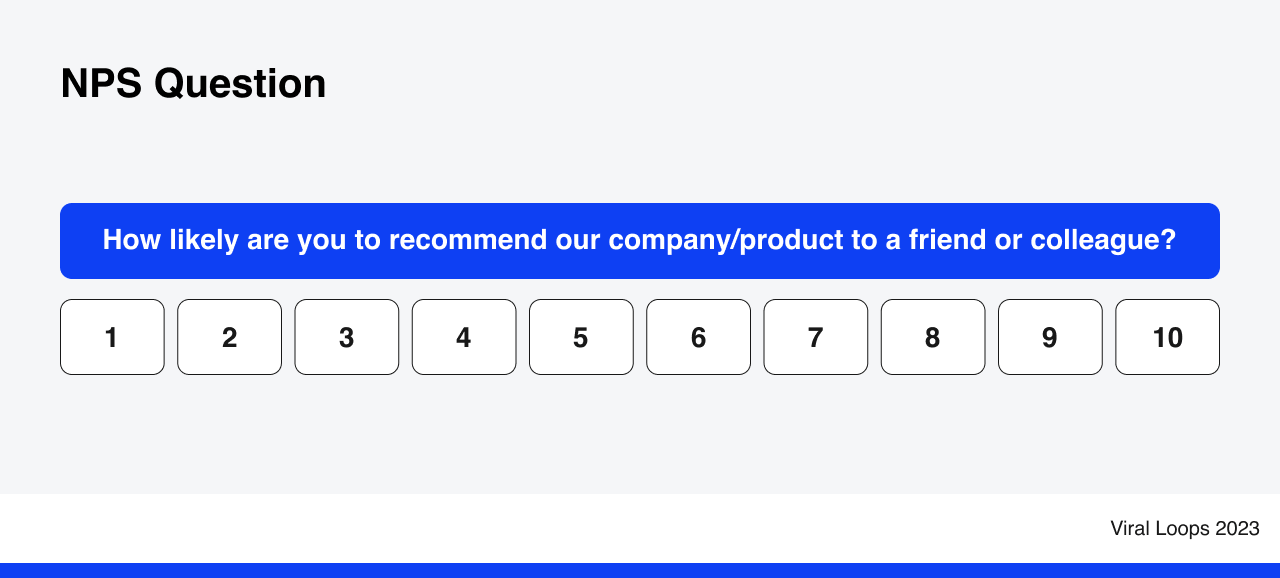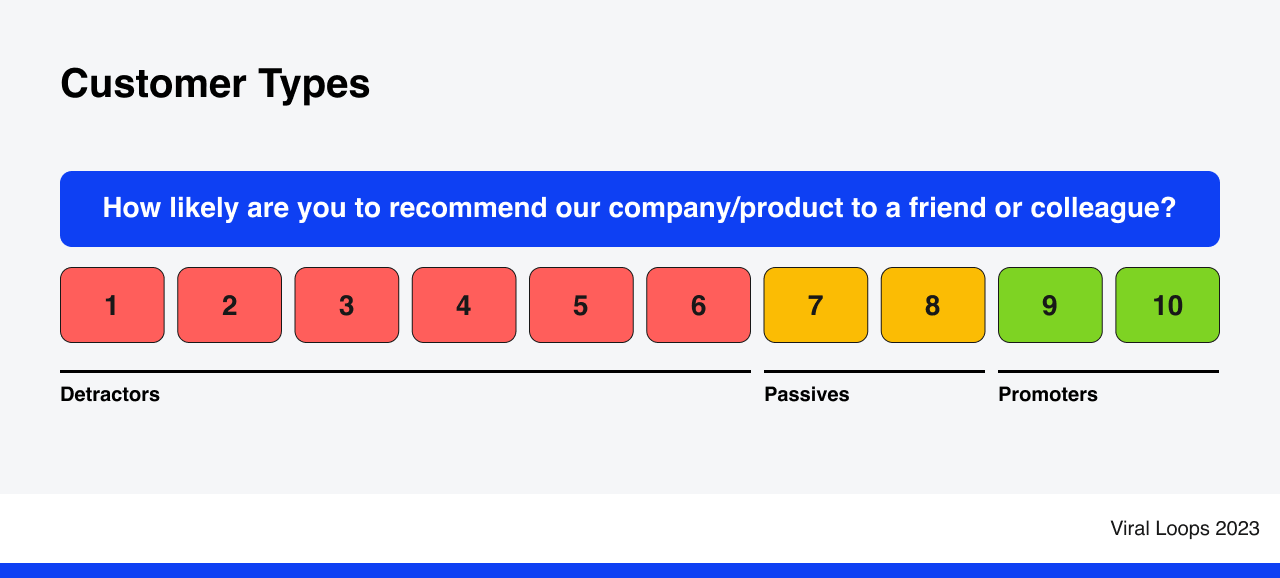Customer satisfaction goes beyond being a trendy term in business growth; it plays a vital role in achieving success.
Think of it like this: would you be likely to return to a company that not only meets but exceeds your expectations? Absolutely! Just like the rest of us, you’d value that kind of experience.
When customers are happy, they stick around. But more than just retaining them, satisfied customers become ambassadors, spreading positive word-of-mouth and bringing in new customers into the fold. That’s the kind of referral marketing businesses dream of, but rarely achieve without a solid understanding of how satisfied customers are.
But how do you know if they’re just content or genuinely delighted? That’s where the Net Promoter Score (NPS) comes in handy. NPS is a powerful tool that reveals the reality of your customers’ experiences. It’s like a compass, guiding your business decisions and strategies based on real customer feedback.
If you find yourself puzzled about the workings and proper utilization of this tool, fret not! That’s what this post is for. This article shall serve as your guiding compass to understanding Net Promoter Score, its advantages, and how to leverage it to propel your business toward growth.
What is Net Promoter Score?
Developed by Fred Reichheld under Bain and Company in 2003, the Net Promoter Score is a customer or client loyalty metric that gauges the likelihood of customers to recommend a company or product to others. This metric is part of the Net Promoter System of management.
It is based on a simple survey question: “How likely are you to recommend our company/product to a friend or colleague?”

Harnessing the benefit of aggregate Net Promoter Scores can prove pivotal for businesses keen on enhancing various aspects such as service quality, customer support, and delivery mechanisms. This focus on improvement, driven by tangible data, paves the way for strengthening customer loyalty.
As a quantifiable business metric, NPS empowers companies, regardless of their size, to rally around a singular, mission-critical goal. This goal is straightforward yet impactful — fortify their score by nurturing a pool of highly satisfied customers.
The beauty of NPS lies in its ability to be tracked and quantified over time, providing a clear progress trajectory for businesses. With each uptick in the score, businesses can rejoice in the knowledge that their customer satisfaction initiatives are indeed yielding fruit.
Net Promoter Score Calculation
Net Promoter Score is derived from the response to the survey question above. Customers can rate their likelihood of sharing the company on a scale of 0-10, with 0 being “Not at all likely” and 10 being “Extremely likely.”
Based on their answers, customers are classified into the following:
- Promoters – Customers who choose 9 or 10. They are highly satisfied and are loyal customers who will spread positive word-of-mouth.
- Passives – Customers who choose 7 or 8. They are satisfied but not enthusiastic enough to actively promote the company.
- Detractors – Customers who choose 0-6. They are unhappy customers who have the potential of spreading negative word-of-mouth that may harm your reputation.

The formula for calculating NPS is simple: Percentage of Promoters minus Percentage of Detractors. This gives you the Net Promoter Score, which can range from -100 (if every customer is a Detractor) to 100 (if every customer is a Promoter).
Here’s how you do it:
- Percentage of Promoters – Count the number of responses that are 9 or 10 (Promoters), and divide by the total number of responses. Multiply by 100 to obtain a percentage.
- Percentage of Detractors – Count the number of responses that are 0-6 (Detractors), and divide by the total number of responses. Multiply by 100 to obtain a percentage.
- NPS Calculation – Subtract the Detractor percentage from the Promoter percentage. The resulting number is your Net Promoter Score.
Once you have the output, the NPS is analyzed as follows:
- Anything above 0 is considered a good score, with scores of 50 and above being excellent.
- Scores between -30 and 0 are deemed satisfactory, but there is room for improvement.
- Scores below -30 require immediate attention as they indicate significant dissatisfaction among customers.
There are also a few ways to evaluate this score, which we will discuss later on.
Using Net Promoter Score for Business Growth
Now that you understand what Net Promoter Score is and how to calculate it, let’s explore its significance for business growth and why it is considered one of the most important metrics during product launch.
Strengthening Brand Reputation
With a high NPS comes a strong brand reputation. As satisfied customers become promoters, they spread positive word-of-mouth, attracting new customers and increasing brand awareness. This can lead to a steady growth in customer base and revenue.
Tailoring Marketing Strategies
Net Promoter Score also allows businesses to target their marketing efforts toward Promoters, who are more likely to engage with the company again and recommend it to others. By understanding what drives customer loyalty, businesses can tailor their marketing strategies accordingly for maximum impact.
Understanding Customer Sentiment
NPS surveys also provide an opportunity for customers to leave open-ended feedback about their experiences. This can give companies insight into customer sentiment and specific pain points that may not have been captured by traditional metrics.
Following up with an open-ended question, such as why the customer provided such feedback, is necessary to provide businesses with more information on the specific areas that they need to improve on.
Identifying Areas for Improvement
NPS helps in identifying areas that require improvement, whether it’s product quality, customer service, or overall experience. By addressing these issues and improving the score, businesses can foster greater customer loyalty and satisfaction.
Benchmarking Performance
With NPS being widely used across industries, companies can also benchmark their NPS against other competitors in the market. This provides a clear picture of where they stand and what steps they can take to improve their score. We’ll talk more about this in a bit.
Predicting Growth Potential
A high NPS not only indicates customer loyalty but also serves as a predictor of future growth potential for the business. As satisfied customers continue to promote and recommend the company, it can lead to increased sales and sustainable growth.
Limitations of Net Promoter Score
Despite its benefits, Net Promoter Score does have its limitations and is not always the most suitable metric because of:
- Lack of Contextual Information – NPS surveys usually involve a single question, which doesn’t provide in-depth insights or specific feedback about the customer experience. For comprehensive customer feedback analysis, other tools may be more suitable.
- Influence of External Factors – NPS can be influenced by external factors outside of your company’s control, such as market trends, making it a potentially inconsistent measure of performance.
- Limitations in Predicting Behavior – Although NPS measures the likelihood of a customer to recommend, it doesn’t necessarily translate to actual behavior. For instance, a Promoter may recommend your product but not repurchase it, and a Detractor may not recommend but continue to purchase your product.
Thus, while Net Promoter Score is an effective tool for certain scenarios, consider its limitations and evaluate whether it fits your specific business needs before use.
When to Best Use Net Promoter Score
Deciding when to ask your customers the Net Promoter Score question is crucial, as timing can significantly impact the responses and, therefore, the score. It’s generally agreed that there are two optimal times for this:
Post-Purchase or After-Service Delivery
This is an opportune time to send the NPS survey, as the customer’s experience with your product or service is still fresh in their mind. They are more likely to provide an accurate account of their satisfaction level, capturing both the highs and the lows.
After Customer Assistance
The period immediately following customer support interaction is another prime opportunity to utilize the NPS survey. This can offer valuable insights into the effectiveness of your support team and the impact of their assistance on customer satisfaction.
Customers who have had their issues resolved effectively are likely to score higher, reflecting positively on your support team’s efficiency. Conversely, lower scores may indicate a need for improvements within your support framework.
Regularly conducting NPS surveys post-support can help your team continually refine their approaches, ensuring that customer concerns are addressed promptly and satisfactorily.
Periodic Check-ins
Regular intervals during the customer lifecycle, such as every quarter or bi-annually, are also good times to check in with your customers. This approach provides insight into the customer’s ongoing relationship with your organization and can help you identify any shifts in their satisfaction over time.
However, it’s important to avoid over-surveying as it can lead to survey fatigue and may impact the response rates. Therefore, it’s crucial to find a balance that works for both the business and the customer.
Evaluating Your Net Promoter Score
Let’s say you already have your Net Promoter Score based on the results of your surveys. What do you do then? Here are three different ways to actually use this metric.
For Performance Benchmark and Comparison
The first method involves comparing your current performance to your past performance.
Analyzing your NPS over time and tracking any significant changes can provide valuable insight into the effectiveness of your customer relationship strategies.
For instance, if your NPS was 40 last year and this year it rose to 55, it indicates a positive improvement in your customer loyalty and satisfaction, likely due to successful initiatives and efforts implemented by your team.
Absolute Net Promoter Score
The second method is through Absolute NPS, which involves comparing your own results against the industry average Net Promoter Scores. This gives you a sense of your standing within your business sector.
Let’s say, for example, you operate a retail business, and your NPS is 60. If the industry average is 50, it signifies your business is performing better in terms of customer loyalty than the industry standard.
To help you determine where you stand, here are the NPS averages in 2023 based on industry, as released by NICE, the co-developer of the Net Promoter Score.
Take note that these are for US-based customers only, with opt-in email as the mode of NPS data collection. More than 63,000 customers were surveyed by 217 brands, coming from 23 industry sectors.
Various factors actively influence the average NPS score, causing it to vary across different industries.
Customer expectations, for instance, play a crucial role. In industries where customers expect high-quality service and receive it as anticipated, the NPS score tends to be higher.
Similarly, the standards of service offered by businesses significantly impact the NPS score. Industries that uphold strict service standards usually achieve better scores.
Additionally, the level of competition within an industry also affects the NPS score. In highly competitive industries, businesses often strive to outdo each other in customer retention, leading to higher average NPS scores.
Relative Net Promoter Score
Lastly, the Relative NPS provides a comparison of your company’s performance against a specific competitor within the same industry. This could be crucial when you’re in a tight competition with a direct rival.
For instance, if your auto insurance company has an NPS of 45 and your top competitor’s score is 60, it suggests that your competitor is doing a better job at ensuring customer satisfaction and loyalty. It means it’s time for you to evaluate and revise your customer experience strategies if you want to be on par with the top company in the industry.
From the same NICE data, the top brands for each industry are as follows (together with their corresponding NPS).
By employing these methods, you can gain a comprehensive perspective on your NPS and use it as a benchmark to drive business growth and customer satisfaction.
Best Practices When Using Net Promoter Score
Before you launch your Net Promoter Score survey, here are a few tips that might help you get the most out of your results.
- Gather at Least 100 Responses – For your data to be valid, you need to gather enough responses. The rule of thumb is to get at least 100 completed surveys.
- Use a Consistent Method for Data Collection – Consistency in data collection is crucial in ensuring the accuracy and reliability of your NPS. Make sure to use the same survey approach across all respondents.
- Keep it Short and Simple – The NPS survey is only one question, making it a quick and straightforward task for customers to complete. Keep the language simple and avoid using technical jargon to ensure that all customers can provide their responses easily.
- Ensure Consistency in Surveying – To accurately track changes in your Net Promoter Scores, it’s essential to keep the surveying process consistent. Avoid changing the question or altering the timing of when you ask for responses.
- Further Probe Detractors and Promoters – While the NPS score is valuable, it’s also crucial to follow up with further questions to identify specific areas of improvement and strengths. To make the follow-up questions relevant, make sure the questions are based on the score they gave you.
For instance, Promoters can receive the following probing questions:
- Tell us what we did best that made you give us a high score.
- What can we do to maintain or improve our performance and ensure you stay satisfied in the future?
This is also a good place to quickly talk to your customers about your referral program since they’re more likely to recommend your company.
Meanwhile, Detractors can receive these follow-up questions:
- What are the main areas you think we need to improve on?
- How can we make it up to you and regain your trust?
- Would you still recommend us to others or not? Why or why not?
Finally, Passives can receive these probing questions:
- What can we do to make you more likely to recommend our business?
- Is there anything that could have pushed your rating higher?
- Act on the Results – The most crucial aspect of using NPS is acting on the results and making changes to improve your customer loyalty levels. Otherwise, it becomes a meaningless number that doesn’t drive any real change within your organization.
- Communicate with Your Customers – Let your customers know their feedback matters by communicating how you’re addressing their concerns and making improvements based on their suggestions. This can help foster a stronger relationship with your customers and increase their loyalty in the long run.
Wrapping Up
In conclusion, gaining proficiency in using the Net Promoter Score as an insightful measure of your company’s performance can significantly enhance your customer experience strategies.
This tool brings to light the nuances of customer loyalty and satisfaction, allowing you to benchmark your performance against your past scores, industry averages, and even your closest competitors.
By following the best practices outlined in this article, you can maximize the potential of NPS and drive your business growth by keeping your customers happy.
Remember, a satisfied customer is a loyal customer who will keep coming back and referring others to your business. Keep striving for improvement, and watch as your business continues to climb the charts!
